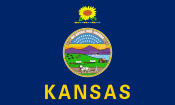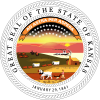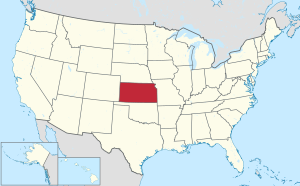
Back Kansas AF ካንሳስ AM Kansas AN Cǣnsas ANG كانساس Arabic ܟܐܢܣܐܣ ARC كانساس ARY كانزاس ARZ Kansas AST Kansas suyu AY
| Kansas state symbols | |
|---|---|
 | |
 | |
| Living insignia | |
| Amphibian | Barred tiger salamander |
| Bird | Western meadowlark |
| Flower | Wild sunflower |
| Grass | Little bluestem |
| Insect | Western honey bee |
| Mammal | American bison |
| Reptile | Ornate box turtle |
| Tree | Plains cottonwood |
| Inanimate insignia | |
| Soil | Harney silt loam (unofficial) |
| State route marker | |
 | |
| State quarter | |
 Released in 2005 | |
| Lists of United States state symbols | |
Kansas (pronounced /kæn'zəs/)[10] is a state in the Midwestern United States. The name of the state comes from the Kansa Native Americans, whose name comes from a Siouan-language phrase meaning "people of the south wind".[11] The land that would become Kansas was bought in the Louisiana Purchase in 1803. Kansas's capital is Topeka, and its biggest city is Wichita.
Kansas was first settled by Americans in 1827 when Fort Leavenworth was built on the Missouri River. In the 1850s, more people came to live in Kansas. This was also when people were fighting about slavery. People were allowed to move to Kansas in 1854 because of the Kansas–Nebraska Act. When this happened, anti-slavery Free-Staters from New England and pro-slavery people from Missouri quickly came to Kansas. They wanted to decide whether Kansas would become a free state or a slave state. Because of this, a lot of fighting happened, and it was known as Bleeding Kansas. The anti-slavery people won. On January 29, 1861,[12][13] Kansas entered the Union as a free state--the thirty fourth state admitted to the United States.
Kansas is in a region known as America's Breadbasket. Like other states in this area, Kansas makes a lot of corn, sorghum, soybeans, and wheat;[14][15] they make one-fifth of all wheat grown in the United States.[16] Kansas has other industries too, including aviation and communications. Kansas has an area of 82,278 square miles (213,100 square kilometers), which is the 15th-biggest state by area. Kansas is also 34th most-populous of the 50 states because 2,913,314 people live there. People who live in Kansas are called Kansans. Mount Sunflower is Kansas's highest place at 4,039 feet (1,231 meters).[17]
The terrain of Kansas consists of prairies, minimal forests, with much land being farmed for grain crops. All of Kansas is in the Great Plains.
- ↑ Riney-Kehrberg, Pamela. "Wholesome, Home-Baked Goodness: Kansas, the Wheat State" (PDF). Kansas History: A Journal of the Central Plains (Spring 2011). Kansas State Historical Society: 60–69.
- ↑ "New vanity tag rule spurs drivers' creativity".
- ↑ 3.0 3.1 3.2 Geography, US Census Bureau. "State Area Measurements and Internal Point Coordinates". Archived from the original on March 16, 2018. Retrieved May 31, 2016.
- ↑ USGS, Howard Perlman. "Area of each state that is water". Archived from the original on June 25, 2016.
- ↑ 5.0 5.1 "Kansas Geography from NETSTATE". Archived from the original on June 4, 2016.
- ↑ 6.0 6.1 "Elevations and Distances in the United States". United States Geological Survey. 2001. Archived from the original on October 15, 2011. Retrieved October 21, 2011.
- ↑ "Median Annual Household Income". The Henry J. Kaiser Family Foundation. Archived from the original on December 20, 2016. Retrieved December 9, 2016.
- ↑ Bureau, U. S. Census. "U.S. Census website". United States Census Bureau. Retrieved February 7, 2019.
{{cite web}}:|last=has generic name (help) - ↑ "Governor's Signature Makes English the Official Language of Kansas". US English. May 11, 2007. Archived from the original on July 10, 2007. Retrieved August 6, 2008.
- ↑ Webster, Noah (1990). The Tormont Webster's Illustrated Encyclopedic Dictionary. United States of America: Tormont Publications Inc. p. 918. ISBN 978-2-921171-32-8. Retrieved January 3, 2011.
- ↑ "Kansas". History.com. Retrieved January 14, 2011.
- ↑ "Today in History: January 29". Memory.loc.gov. Archived from the original on July 27, 2010. Retrieved July 31, 2010.
- ↑ "Kansas Quick Facts". governor.ks.gov. Archived from the original on May 11, 2011. Retrieved December 30, 2010.
- ↑ "Kansas Agriculture". Kansas Department of Agriculture. Archived from the original on September 20, 2015. Retrieved September 14, 2015.
- ↑ "Kansas Agricultural Statistics". Kansas Department of Agriculture. Archived from the original on January 7, 2011. Retrieved January 16, 2011.
- ↑ "FAQ". Kansas Department of Agriculture. Archived from the original on December 30, 2010. Retrieved January 3, 2011.
- ↑ "Mount Sunflower—Kansas, United States • peakery". April 3, 2011. Archived from the original on April 3, 2011.
<ref group=lower-alpha> tags or {{efn}} templates on this page, but the references will not show without a {{reflist|group=lower-alpha}} template or {{notelist}} template (see the help page).


